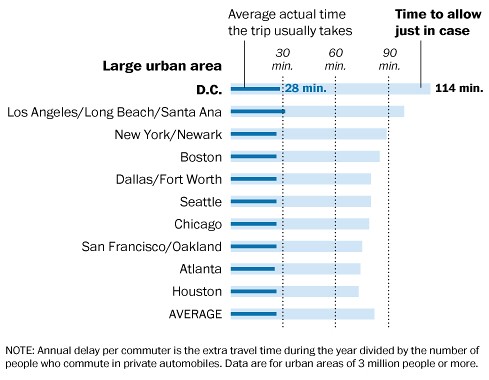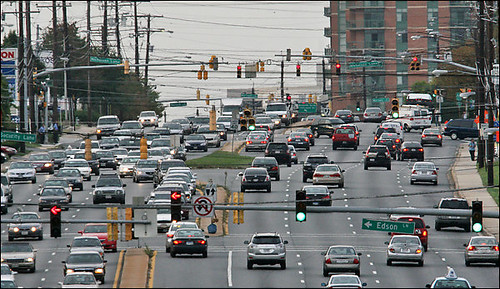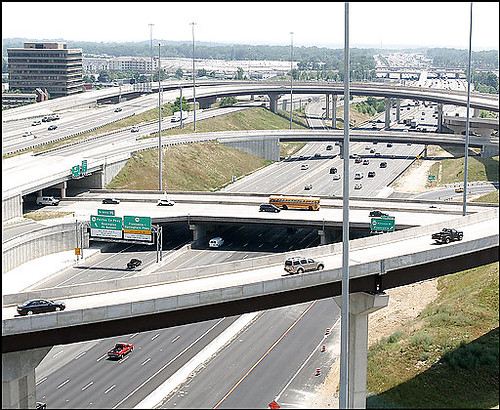That problem again: conflating the city and the metropolitan area and the annual report on traffic congestion
The Texas A&M Transportation Institute released its annual study, the 2012 Urban Mobility Report, on traffic congestion in the nation's metropolitan areas.
 But because the center city of a metropolitan area and the metropolitan area are referred to by the same name, typically people think it's "the city" with the problem when usually (not always) the biggest problems are on the freeways and in the suburbs.
But because the center city of a metropolitan area and the metropolitan area are referred to by the same name, typically people think it's "the city" with the problem when usually (not always) the biggest problems are on the freeways and in the suburbs.The Washington Post story "Washington rated the worst for traffic congestion — again" (Post graphic right) doesn't distinguish between the city and metropolitan area in the headline, but does, sort of, in the article, although it goes back and forth.
For those of us not relying on driving to and from and within the city, we do just fine.
What concerns me about the reporting is how it shapes perceptions of the issue and proposed solutions.
For example, people might think that "Washington, DC" proper should do a congestion charge, to deal with congestion (actually I think HOV-2 requirements on rush hour streets would go pretty far in terms of having a positive impact on traffic within the city), but the reality is that most of the real "congestion" is outside the city, and a charge in the city, but not outside of it, would end up diverting more commerce to the suburbs away from the city.
Or people would argue that we need to spend more money on roads for motor vehicles, when people throughput, at least in the city of Washington, is best maximized by transit, complemented by walking and to some extent biking.
As Jane Jacobs once said, when someone asked her "why aren't there enough roads?" ... "You're asking the wrong question. The right question is 'why are there so many cars?'"
Etc.

Rockville Pike in the White Flint area. Washington Post photo by Bill O'Leary.

Springfield mixing bowl (I-395). Washington Post photo by Richard Lipski.
Labels: car culture and automobility, traffic, traffic engineering, transportation planning, urban design/placemaking



6 Comments:
again, the WaPO shows why it is not a home town paper- that their reporters get the city and suburbs mixed up is a sure sign that the reporter is not from this area- at one time ALL WaPO reporters lived int he city- now it appears MOST of them are from another place and do not live in the city at all. Their local coverage of most things is awful and has gotten worse. maybe it would be apporpriate for them to leave DC and decamp to Virginia where they could change the name- of course- despite their constant critiques and downplaying of the city- no one in the rest of the world would recognize Virginia as being as important as WASHINGTON
No question the traffic clusterfuck that is suburban washington is driving a lot of young people to move into the district. Of course the numbers aren't pointing that out -- I think MD and VA aren't major causes of DC immigration.
And DC is doubly helped that good chunks of Arlington (outside R-B), Alex, and inner MD have extremely poor housing quality and livability. If I have to choose between Truxton Circle and Fairlington, which is a better choice right now?
That being said, DC does need to do a better job of managing car exits. I realize the DC nationalists get upset about this, but having high-status jobs in DC really acts a mulitplier. How many partners of law firms live in DC vs. Mclean and potomac?
many parts of the city are basically traffic free during the weekends and even weekdays- it is a disservice and insult to DC that these stupid and innaccurate reports go unchallenged and are taken as factual when they have nothing at all to do with theh the city proper. It is not only inaccurate reporting- I would go so far as to call this kind of trash unethical.
Get over this. There has to be a regional label. When ANY other city is mentioned in this fashion, people know that it refers to a metropolitan area, whether its LA, New York, Chicago or anywhere else.
I am not saying don't refer to an area as X based on the name of the center city. It's just that the reporting on studies of metropolitan scale data usually fails to distinguish the proper scale. That really matters wrt transportation-related matters.
This is a great post.
This post is about conflating city.
Traffic congestion is a condition on transport that is portrayed by more slow speeds, longer excursion times, and expanded vehicular queueing.
Visit here-"buy medicine online".
Post a Comment
<< Home